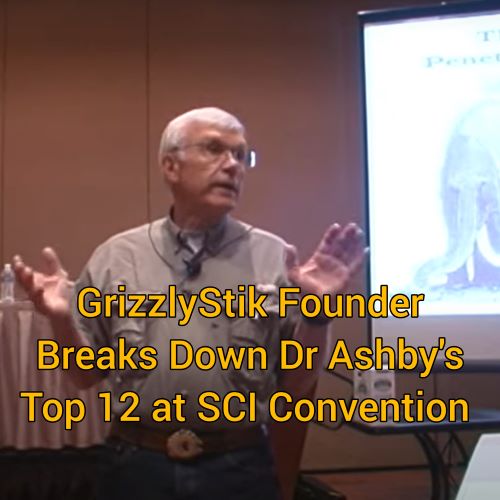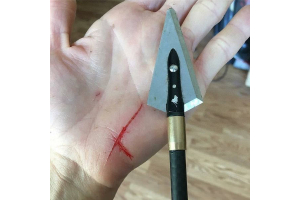Dr Ed Ashby 2021 Case Study - Cape Buffalo

2021 Cape Buffalo CASE STUDY
ABF CASE STUDY: CAPE BUFFALO (Syncerus caffer)
LOCATION: SOUTH AFRICA
DATE: JULY 2021
RE: RESULTS OF TWO BLADE BROADHEAD TESTS ON CAPE BUFFALO
BROADHEADS TESTED:
- 300 gr original Tuffhead
- 300 gr Evolution Tuffhead
- 315 gr Ashby by GrizzlyStik
- 315 gr Bishop Scientific Method
- 200 gr Maasai by GrizzlyStik
- 210 gr Silver Flame by GrizzlyStik
- 200 gr Evolution by Tuffhead
- 200 gr Single Bevel Iron Will
- 200 gr Bishop Scientific Method
- 200 gr Double Bevel Iron Will
Comments:
For this test, we looked at what the Cape Buffalo did to the broadhead - not what the broadhead did to the Cape Buffalo. For all broadheads, we looked at structural integrity, mechanical advantage including edge bevel MA, broadhead silhouette, tip design, positives, negatives, questions arising for further testing, and pre-shot and post-shot sharpness. Except for the 210 grain Silver Flame, all tested broadheads are currently available to the public, and all test shots were taken at 20 yards, 90 degrees broadside. Multiples of each head were shot for consistency, and the test medium was the southern Cape Buffalo (Syncerus caffer). Testing was done by Rob Neilson and Rhonda Jones w/ABF, and Tony DuBryn w/PHASA (Professional Hunter’s Association of South Africa).
The bows used and arrows/heads shot from each:
- 82# Hoyt Faktor 34” compound bow, 29” DL: 300+ grain heads were used with arrow weights from 1135 to 1210 gr, depending on the head weight. The shafts utilized were GrizzlyStik 170 spine shafts, with a FOC of 30-31%.
- 39# Mathews Avail compound bow, 25.5” DL:. Test shots were made using the 315 Ashby on a GrizzlyStik 320 wildcat cut shaft with total weight of 775 gr and 31% FOC.
- 72# Hoyt Axius Ultra compound bow with a 29” DL. 200 Grain heads were used with arrow weights from 665 - 675 gr, depending on the head weight. The shafts utilized were GrizzlyStik 240 spine shafts, with a FOC of 25%.
The 315 grain Alaskan by GrizzlyStik was not used for the test and is not part of this case study’s summary results. However, this is a proven recipe and therefore was part of the 1150 grain, 30% FOC arrow system used to kill the animals (with complete pass- throughs), enabling us to conduct the testing. That information will be plugged into the database on hunted animals.
A special THANK YOU to Tony DuBryn w/Wild Wildebeest Safaris and PHASA representative for his hospitality while in South Africa, lining up the hunt for Cape Buffalo and for helping with this testing, which could not have been possible without him. Also, a special THANK YOU to Ron Schwarz at KME Sharpeners for building and donating to ABF a custom broadhead holder to accurately and consistently test the sharpness of broadheads utilizing the Edge-On-Up BESS sharpness tester.
A reminder Ashby Bowhunting Foundation is a 501(c)(3) non-profit organization and as with all testing, the Foundation accepts no funding from the archery industry, keeping all testing truly independent of industry influence. All Board Members and Ambassadors are unsalaried volunteers. Please donate. Your donations make our continuing independent research possible.
300+ GRAIN HEADS:
82# Test Bow, 29” DL, 170 Spine GrizzlyStik Tapered Shaft w/315 Grain Grizzlystik Ashby, 1150 grains total weight, 30% FOC, 200 fps, Impact Momentum 1.021 slug ft/sec: The original 315 Grain Ashby is a known and proven single bevel in hunting situations. Structural integrity during testing was solid, great mechanical advantage broadhead and 25-degree bevel for sharpness. Smooth transitions from tip to tail with no bumps to impede penetration. While the head did well, we would like to see the ferrule fading out closer to the tip for lateral support as, in prior testing, we have seen that to be a potential point of weakness. Pre-shot sharpness testing was in the BESS razorblade category requiring 50 grams of pressure, and post-shot in the utility razor blade category requiring 188 grams of pressure. Post-shot sharpness on this head is sharper than others pre-shot sharpness measurement. All shots were full pass-throughs.
82# Test Bow, 29” DL, 170 Spine GrizzlyStik Tapered Shaft w/300 gr Original Tuffhead w/75 gr Titanium adapter, 1210 grains total weight, 31% FOC, 196 fps, Impact Momentum 1.053 slug ft/sec: The original Tuffhead is a known and proven single bevel in hunting situations. Structural integrity during testing was solid, best mechanical advantage of the group and 25-degree bevel for sharpness. Smooth transitions from tip to tail with no bumps to impede penetration. While the head did well, we would like to see the trailing end of the head sharpened. Pre-shot sharpness testing was in the BESS utility razorblade category requiring 199 grams of pressure, and post- shot in the high-end cutlery category requiring 332 grams of pressure. Post-shot sharpness on this head is sharper than others pre-shot sharpness measurement. All shots were full pass-throughs.
82# Test Bow, 29” DL, 170 Spine GrizzlyStik Tapered Shaft w/300 gr Evolution Tuffhead, 1135 grains total weight, 30% FOC, 201 fps, Impact Momentum 1.013 slug ft/sec: The newer lineup offering from Tuffhead made with S7 steel with a 20-degree bevel. Structural integrity during testing was solid, good mechanical advantage and a 20- degree bevel for sharpness with a slick finish. The head has a smooth transition from tip to tail, no bumps to impede penetration. As with all our heads, we would like to see the trailing end of the head sharpened. Pre-shot sharpness tested was in the BESS utility razorblade category requiring 160 grams of pressure, and post-shot in the high-end cutlery category requiring 290 grams of pressure. Post-shot sharpness on this head is sharper than others pre-shot sharpness measurement. All shots were full pass-throughs.
82# Test Bow, 29” DL, 170 Spine GrizzlyStik Tapered Shaft w/315 Bishop Scientific Method, 1150 grains total weight, 30% FOC, 200 fps, Impact Momentum 1.021 slug ft/sec: ABF and PHASA were anxious to test this head, as all PH accounts with hunters utilizing this head have not made a pass through on a Cape Buffalo, with many being
followed up with a gun due to lack of penetration. The structural integrity on this head is solid with the S7 steel, good mechanical advantage of the head design, but the steeper 40-degree bevel is built more for durability than sharpness. The head has a smooth transition from tip to tail, no bumps to impede penetration. On impact of all Bishop heads, there was a visual skip angle/re-direction of the entire arrow system, indicating a design flaw. We will study this head on impacts with the aid of our high-speed camera to confirm exactly what is happening with this head. The 40-degree bevel pre-shot sharpness testing required 460 grams of pressure, and the post-shot sharpness required 757 grams of pressure, both in the BESS category of need maintenance or repair. The Bishop Scientific Method heads achieved an average 12.5” of penetration in this testing and did not pass- through the animal.
39# Bow, 25.5” DL, 320 W/C GrizzlyStik Shaft w/315 Grain Grizzlystik Ashby, 775 grains total weight, 30% FOC, 150fps, Impact Momentum .5162 slug ft./sec: Similar results as the test done with this head from the 82# bow but achieved an average of 22” of penetration into the thoracic cavity, stopping against the offside rib cage. While this arrow system did not pass through, this was from a low poundage, short draw, less efficient bow but still enough penetration to be lethal.
300+ grain head synopsis:
All three of these manufacturers produced broadheads that were built well enough to make it to this stage of testing. With this type of testing, weaknesses will be exposed and should be used as a positive for improvement. Apart from the Bishop Scientific Method, the poorest performing head over 300 grains, all 300+ grain heads tested with an overall weight of 1135 to 1210 gr from the 82# bow passed-through the Cape Buffalo. A key takeaway from this testing cycle is the effect of broadhead efficiency on outcome arrow penetration. Note that the 775-grain arrow from a 39# bow with an efficient broadhead penetrated better than the 1150 grain arrow off an 82# bow with the less efficient Bishop broadhead. That is 43# more draw weight of bow, 375 grains greater arrow mass, and .5 slug ft more impact momentum that could not overcome a lower efficiency broadhead design. While Bishop has some positive features, there are some improvements to be made to eliminate the skip-angle we witnessed along with the lack of sharpness. Other 300+ grain two-blade heads were reviewed and eliminated prior to this testing for various reasons, i.e., poor designs, lack of sharpness, lack of smooth transitions, history of failing on lesser game, etc. The animals we hunt deserve the best we can put forward to kill them quickly and cleanly.
Post-shot picture of the three manufacturers 300+ Grain Heads Tested, from top to bottom: Tuffhead Evolution 300, GrizzlyStik Ashby 315, Original Tuffhead 300 w/75 gr Titanium adapter, Bishop 315.
(Note: Replacement pic of Bishop 315 as author left his Bishop 315 heads in Africa – there was no structural integrity damage from the test shots.)
200+ GRAIN HEADS:
72# Test Bow, 29” DL, 240 spine GrizzlyStik shaft w/200 grain Maasai, 665 grains total weight, 25% FOC, 240 fps, Impact Momentum .7086 slug ft/sec: The 200 Grain Maasai is a convex design, making it stronger geometrically than a straight blade. Structural integrity on the testing was solid. It is shorter than the 300 grain heads tested, but decent mechanical advantage broadhead and a 25-degree bevel for sharpness. Smooth transitions from tip to tail with no bumps to impede penetration. Two screws are utilized to attach the blade securely to the ferrule which is common. Pre-shot sharpness testing was in the BESS razorblade category requiring 88 grams of pressure, and post- shot in the high-end cutlery range requiring 262 grams of pressure. Post-shot sharpness on this head is sharper than others pre-shot sharpness measurement. This setup gave full pass-throughs, going through rib bones on both sides. Only rib bones encountered.
72# Test Bow, 29” DL, 240 spine GrizzlyStik shaft w/210 grain Silver Flame, 675 grains total weight, 25% FOC, 238 fps, Impact Momentum .7133 slug ft/sec: The 210 Grain Silver Flame is a convex design, making it stronger geometrically than a straight blade. This is the unicorn double bevel as it is no longer manufactured, and out penetrated all other 200 grains single bevel heads in the test except the Maasai. Structural integrity on the testing was solid. It is shorter than the 300 grain heads tested, but a decent mechanical advantage broadhead. Smooth transitions from tip to tail with no bumps to impede penetration. Two screws are utilized to attach the blade securely to the ferrule which is common. Pre-shot sharpness testing was in the BESS razorblade category requiring 91 grams of pressure, and post-shot in the razorblade category requiring 163 grams of pressure. Post-shot sharpness on this head is sharper than others pre-shot sharpness measurement. This setup achieved penetration with the broadhead tip piercing, but not passing through, the offside hide of the Cape Buffalo. Only rib bones encountered. Note that the 200 grain Maasai and 200 grain Silver Flame, excepting the tip design, have near identical profiles and Mechanical Advantages yet there is a marked increase in outcome penetration, again demonstrating the single-bevel's penetration advantage on bone impacts.
72# Test Bow, 29” DL, 240 spine GrizzlyStik shaft w/200 grain Evolution Tuffhead, 665 grains total weight, 25% FOC, 240 fps, Impact Momentum .7086 slug ft/sec: The 200 Grain Tuffhead is a short delta shaped head with a 20-degree bevel for sharpness and a slick finish. It is shorter than the Maasai and Silver Flame, therefore less mechanical advantage. Smooth transitions from tip to tail with no bumps to impede penetration. Unlike the Maasai and Silver Flame, it is a one-piece design made from S7 steel. Pre-shot sharpness testing was in the BESS utility razorblade category requiring 153 grams of pressure and a post-shot in the high-end cutlery range requiring 223 grams of pressure. Post-shot sharpness on this this head is sharper than others pre-shot sharpness. This setup averaged 23” of penetration, with the broadhead sticking in the off-side rib. Only rib bones encountered. This also makes an interesting comparison of the effects of arrow design and broadhead Mechanical Advantage on outcome penetration. Compare these results with the test shot results from the 39# Compound.
72# Test Bow, 29” DL, 240 spine GrizzlyStik shaft w/200 grain Iron Will Single Bevel, 665 grains total weight, 25% FOC, 240 fps, Impact Momentum .7086 slug ft/sec: The Iron Will is a short, delta shaped head with a 32-degree bevel, built for a combination of sharpness and durability. It is made of A2 steel and shorter than the Silver Flame or Maasai, therefore less mechanical advantage. The ferrule has an abrupt radius and does not transition smoothly toward the tip for lateral support as preferred. The blade is held in place by one screw, while the preference would be two. The base of the ferrule diameter is 5/16” limiting this head to skinny shafts. In this testing, these broadheads averaged 21” of penetration, not touching the off-side ribs. There was typical dulling on all heads, with one breaking off the tip in front of the ferrule radius and having excessive chatter for a 32- degree bevel designed with durability in mind. The one screw held the blade in place, but we noticed the blade rotated slightly. Pre-shot sharpness testing was in the BESS utility razorblade category of 151 grams of pressure. Post-shot sharpness ranged from 373 grams of pressure on the heads that did not exhibit any structural issues, to 1071 grams of pressure on the head that had structural issues. Only on-side rib bones encountered.
72# Test Bow, 29” DL, 240 spine GrizzlyStik shaft w/200 grain Bishop Scientific Method, 665 grains total weight, 25% FOC, 240 fps, Impact Momentum .7086 slug ft/sec: The 200 Grain Bishop Scientific Method is a short delta shaped head and a 40- degree bevel built more for durability than sharpness. It is built with S7 steel and has smooth transitions from tip to tail with no bumps to impede penetration. As mentioned with other heads, the preference is for the ferrules to transition smoothly closer to the tip of the blades for additional lateral support. The structural integrity was solid on the testing, but as with the 315 Bishop, upon impact we witnessed a skip/re-direction of the entire arrow system, indicating a design flaw. We will study this head on impacts with the aid of our high-speed camera to confirm what is happening with this head. The 40-degree bevel pre-shot sharpness testing required 542 grams of pressure with the post-shot sharpness was 670 grams of pressure, both in the BESS category of need maintenance or repair. The Bishop Scientific Method heads achieved an average 20” of penetration in this testing and did not pass through the animal. Only on-side rib bones encountered.
72# Test Bow, 29” DL, 240 spine GrizzlyStik shaft w/200 grain Iron Will Double Bevel, 665 grains total weight, 25% FOC, 240 fps, Impact Momentum .7086 slug ft/sec: This is Iron Will’s Double Bevel head and the blue-print for building their single bevel. It is the same short delta shaped head with minimal mechanical advantage. This has the same design issues that were noted on the single bevel, so no need to repeat here. These broadheads penetrated the least with an average of 20”, not reaching the off-side ribs. The A2 steel in double bevel form performed well structurally, with typical dulling. Pre-shot sharpness testing was in the BESS utility razorblade category requiring 161 grams of pressure, and post-shot sharpness in the category of needing maintenance or repair requiring 405 grams of pressure. Only rib bones encountered. The two Iron Will heads in this test being identical except for edge bevel makes an interesting outcome comparison of the effects of a single bevel and double bevel design with the single bevel achieving an additional 1” of average penetration in this testing.
200+ grain head synopsis:
These manufacturers produced broadheads that were built well enough to make it to this stage of testing. With this type of testing, weaknesses will be exposed and should be used as a positive for improvement. GrizzlyStik and Tuffhead, based on history and this testing, continue to impress. Iron Will is a younger company and has a lot of positives, builds an overall good head, and the shortcomings mentioned in this case study will likely be improved upon over time. Bishop also has some positive features, but as noted above, there are some issues with the design that should be improved. Note many other 200 grain two-blade heads were reviewed and eliminated prior to this testing for various reasons, poor designs, lack of sharpness, lack of smooth transitions, history of failing on lesser game, etc. The animals we hunt deserve the best we can put forward to kill them quickly and cleanly.

Of all the 200 grain broadheads tested, Iron Will had the most issues with breaking, edge chatter and overall penetration.
Post-shot picture of 200 Grain Heads Tested, from top to bottom: GrizzlyStik Maasai, GrizzlyStik Silver Flame, Tuffhead Evolution 200, Iron Will Single Bevel, Iron Will Double Bevel,
Bishop 200 Scientific Method.
*NOTE: The average outcome penetration achieved by the 315 grain GS Ashby from the 39# bow is a dramatic example of the advantage achieved when using a fully penetration-maximized (12 Factor) arrow setup
SHARPNESS TESTER:
BESS CHART:
Pre and post sharpness measurements were done 3x with each broadhead to confirm consistency. The sharpness tester measures in grams of pressure (force) to cut through its test media. See BESS chart for reference on where these heads fall pre and post sharpness. For a quick conversion, 1 gram equals 15.4324 grains.











